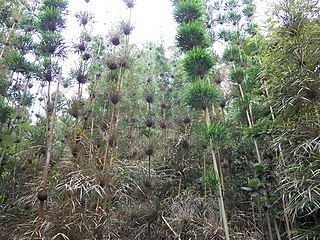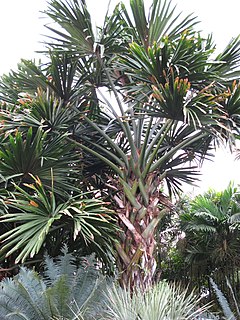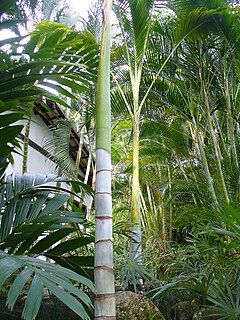
Areca is a genus of about 50 species of palms in the family Arecaceae, found in humid tropical forests from China and India, across Southeast Asia to Melanesia. The generic name Areca is derived from a name used locally on the Malabar Coast of India.

Salacca is a genus of about 20 species of palms native to Southeast Asia and the eastern Himalayas.

Calamus is a genus of the palm family Arecaceae. These are among several genera known as rattan palms. There are an estimated 400 species in this genus, all native to tropical and subtropical Asia, Africa, and Australia. They are mostly leaf-climbing lianas with slender, reedy stems. To aid scrambling some species have evolved hooks on the underside of the midrib, or more commonly by modified "pinnae" or tendrils in the form of stout, backward-pointing spines. These stems may grow to lengths of 200 metres.

The Bambuseae are the most diverse tribe of bamboos in the grass family (Poaceae). It consists of woody species from tropical regions, including some giant bamboos. Their sister group are the small herbaceous bamboos from the tropics in tribe Olyreae, while the temperate woody bamboos (Arundinarieae) are more distantly related. The Bambuseae fall into two clades, corresponding to species from the Neotropics and from the Paleotropics.

Livistona is a genus of palms, native to southern, southeastern and eastern Asia, Australasia, and the Horn of Africa. They are fan palms, the leaves with an armed petiole terminating in a rounded, costapalmate fan of numerous leaflets.

Guadua is a Neotropical genus of thorny, clumping bamboo in the grass family, ranging from moderate to very large species.
Hickelia is a genus of African bamboo in the grass family.
- Hickelia africanaS.Dransf. - Tanzania
- Hickelia alaotrensisA.Camus - Madagascar
- Hickelia madagascariensisA.Camus - Madagascar
- Hickelia perrieri(A.Camus) S.Dransf. - Madagascar

Nastus is a genus of slender, erect, scrambling or climbing bamboos in the grass family. It is native to Southeast Asia, Papuasia, and certain islands in the Indian Ocean.
Temburongia is a genus of bamboo from the Sultanate of Brunei on the Island of Borneo. It is usually classified in the subtribe Shibataeinae, though its exact relationship with the subtribe remains unclear.

Borassodendron is a genus of flowering plant in the Arecaceae family. It contains two species, native to Southeast Asia.

Clinostigma is a genus of flowering plant in the Arecaceae (palm) family, native to various islands in the western Pacific. It contains the following species:
Marojejya is a genus of flowering plant in the Arecaceae family. It contains the following two species, both endemic to Madagascar:
- Marojejya darianiiJ.Dransf. & N.W.Uhl
- Marojejya insignisHumbert

Pinanga is a genus of flowering plant of the palm family in the sub-tribe Arecinae. It is native to eastern and southern Asia across to New Guinea.
Wettinia is a palm genus, consisting of flowering plants in the Arecaceae family. The genus, established in 1837, contains some 20 species, but more seem to await discovery considering that 4 species - W. aequatorialis, W. lanata, W. minima and W. panamensis - were described as late as 1995. The genus is broadly divided into two groups. One group has the fruits tightly packed, while the other, formerly classified as genus Catoblastus, has fruits scattered along the inflorescence branches. It is not known whether these groups are both monophyletic. The genus is named after Frederick Augustus II of Saxony, of the House of Wettin.
Orania is a genus of the Arecaceae family of palm trees, and includes flowering plants native to Southeast Asia, Madagascar, and New Guinea.
Maxburretia is a genus of three rare species of palms found in southern Thailand and Peninsular Malaysia. The genus is named in honor of Max Burret.
- Maxburretia furtadoanaJ.Dransf. - southern Thailand
- Maxburretia gracilis(Burret) J.Dransf - southern Thailand, Langkawi Islands
- Maxburretia rupicola(Ridl.) Furtado - Selangor
Cathariostachys is a genus of Madagascan bamboo in the grass family.
- Cathariostachys capitata - eastern Madagascar
- Cathariostachys madagascariensis(A.Camus) S.Dransf. - central Madagascar
John Dransfield is an honorary research fellow and former head of palm research at the Royal Botanic Gardens, Kew, United Kingdom, as well as being an authority on the phylogenetic classification of palms.
Sirochloa is a genus of bamboo in the grass family.
Cyrtochloa is a genus of Philippine bamboo in the grass family.











